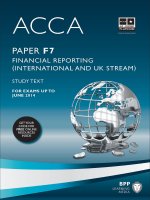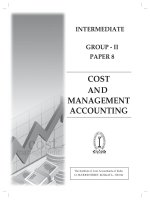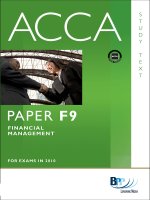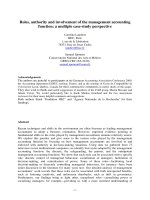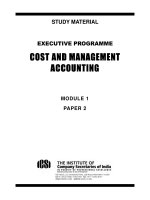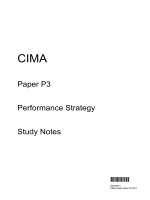CIMA paper 1 management accounting study text
Bạn đang xem bản rút gọn của tài liệu. Xem và tải ngay bản đầy đủ của tài liệu tại đây (3.1 MB, 70 trang )
CIMA
Paper P1
Management Accounting
Study Text
Published by: Kaplan Publishing UK
Unit 2 The Business Centre, Molly Millars Lane, Wokingham, Berkshire RG41 2QZ
Copyright © 2015 Kaplan Financial Limited. All rights reserved.
No part of this publication may be reproduced, stored in a retrieval system or transmitted in any form
or by any means electronic, mechanical, photocopying, recording or otherwise without the prior written
permission of the publisher.
Acknowledgements
We are grateful to the CIMA for permission to reproduce past examination questions. The answers to
CIMA Exams have been prepared by Kaplan Publishing, except in the case of the CIMA November
2010 and subsequent CIMA Exam answers where the official CIMA answers have been reproduced.
Notice
The text in this material and any others made available by any Kaplan Group company does not
amount to advice on a particular matter and should not be taken as such. No reliance should be
placed on the content as the basis for any investment or other decision or in connection with any
advice given to third parties. Please consult your appropriate professional adviser as necessary.
Kaplan Publishing Limited and all other Kaplan group companies expressly disclaim all liability to any
person in respect of any losses or other claims, whether direct, indirect, incidental, consequential or
otherwise arising in relation to the use of such materials.
Kaplan is not responsible for the content of external websites. The inclusion of a link to a third party
website in this text should not be taken as an endorsement.
British Library Cataloguing in Publication Data
A catalogue record for this book is available from the British Library.
ISBN: 9781784152994
Printed and bound in Great Britain.
ii
Contents
Page
Chapter 1
Traditional costing
Chapter 2
Activitybased costing
47
Chapter 3
Other costing techniques
81
Chapter 4
The modern manufacturing environment and the 127
importance of quality
Chapter 5
Breakeven analysis
167
Chapter 6
Relevant costs and decision making
223
Chapter 7
Linear programming
275
Chapter 8
Variance analysis: calculations
307
Chapter 9
Variance analysis: discussion elements
393
Chapter 10
Advanced variances
415
Chapter 11
The budgeting framework
481
Chapter 12
Budgetary control
535
Chapter 13
Forecasting techniques
575
Chapter 14
The treatment of uncertainty and risk in decision 615
making
1
iii
iv
chapter
Intro
Introduction
v
How to use the materials
These official CIMA learning materials have been carefully designed to
make your learning experience as easy as possible and to give you the best
chances of success in your Objective Test Examination.
The product range contains a number of features to help you in the study
process. They include:
•
•
•
a detailed explanation of all syllabus areas
extensive ‘practical’ materials
generous question practice, together with full solutions.
This Study Text has been designed with the needs of home study and
distance learning candidates in mind. Such students require very full
coverage of the syllabus topics, and also the facility to undertake extensive
question practice. However, the Study Text is also ideal for fully taught
courses.
The main body of the text is divided into a number of chapters, each of
which is organised on the following pattern:
vi
•
Detailed learning outcomes. These describe the knowledge
expected after your studies of the chapter are complete. You should
assimilate these before beginning detailed work on the chapter, so that
you can appreciate where your studies are leading.
•
Stepbystep topic coverage. This is the heart of each chapter,
containing detailed explanatory text supported where appropriate by
worked examples and exercises. You should work carefully through this
section, ensuring that you understand the material being explained and
can tackle the examples and exercises successfully. Remember that in
many cases knowledge is cumulative: if you fail to digest earlier
material thoroughly, you may struggle to understand later chapters.
•
Activities. Some chapters are illustrated by more practical elements,
such as comments and questions designed to stimulate discussion.
•
•
Question practice. The text contains three styles of question:
– Examstyle objective test questions (OTQs)
–
‘Integration’ questions – these test your ability to understand topics
within a wider context. This is particularly important with
calculations where OTQs may focus on just one element but an
integration question tackles the full calculation, just as you would be
expected to do in the workplace.
–
‘Case’ style questions – these test your ability to analyse and
discuss issues in greater depth, particularly focusing on scenarios
that are less clear cut than in the Objective Test Examination, and
thus provide excellent practice for developing the skills needed for
success in the Operational Level Case Study Examination.
Solutions. Avoid the temptation merely to ‘audit’ the solutions
provided. It is an illusion to think that this provides the same benefits as
you would gain from a serious attempt of your own. However, if you are
struggling to get started on a question you should read the introductory
guidance provided at the beginning of the solution, where provided, and
then make your own attempt before referring back to the full solution.
If you work conscientiously through this Official CIMA Study Text according
to the guidelines above you will be giving yourself an excellent chance of
success in your Objective Test Examination. Good luck with your studies!
Quality and accuracy are of the utmost importance to us so if you spot an
error in any of our products, please send an email to
with full details, or follow the link to the
feedback form in MyKaplan.
Our Quality Coordinator will work with our technical team to verify the error
and take action to ensure it is corrected in future editions.
Icon Explanations
Definition – These sections explain important areas of knowledge which
must be understood and reproduced in an assessment environment.
Key point – Identifies topics which are key to success and are often
examined.
Supplementary reading – These sections will help to provide a deeper
understanding of core areas. The supplementary reading is NOT optional
reading. It is vital to provide you with the breadth of knowledge you will need
to address the wide range of topics within your syllabus that could feature in
an assessment question. Reference to this text is vital when self
studying.
Test your understanding – Following key points and definitions are
exercises which give the opportunity to assess the understanding of these
core areas.
vii
Illustration – To help develop an understanding of particular topics. The
illustrative examples are useful in preparing for the Test your understanding
exercises.
Exclamation mark – This symbol signifies a topic which can be more
difficult to understand. When reviewing these areas, care should be taken.
Study technique
Passing exams is partly a matter of intellectual ability, but however
accomplished you are in that respect you can improve your chances
significantly by the use of appropriate study and revision techniques. In this
section we briefly outline some tips for effective study during the earlier
stages of your approach to the Objective Test Examination. We also
mention some techniques that you will find useful at the revision stage.
Planning
To begin with, formal planning is essential to get the best return from the
time you spend studying. Estimate how much time in total you are going to
need for each subject you are studying. Remember that you need to allow
time for revision as well as for initial study of the material.
With your study material before you, decide which chapters you are going to
study in each week, and which weeks you will devote to revision and final
question practice.
Prepare a written schedule summarising the above and stick to it!
It is essential to know your syllabus. As your studies progress you will
become more familiar with how long it takes to cover topics in sufficient
depth. Your timetable may need to be adapted to allocate enough time for
the whole syllabus.
Students are advised to refer to the notice of examinable legislation
published regularly in CIMA’s magazine (Financial Management), the
students enewsletter (Velocity) and on the CIMA website, to ensure they
are uptodate.
The amount of space allocated to a topic in the Study Text is not a very
good guide as to how long it will take you. The syllabus weighting is the
better guide as to how long you should spend on a syllabus topic.
Tips for effective studying
(1) Aim to find a quiet and undisturbed location for your study, and plan as
far as possible to use the same period of time each day. Getting into a
routine helps to avoid wasting time. Make sure that you have all the
materials you need before you begin so as to minimise interruptions.
viii
(2) Store all your materials in one place, so that you do not waste time
searching for items every time you want to begin studying. If you have to
pack everything away after each study period, keep your study
materials in a box, or even a suitcase, which will not be disturbed until
the next time.
(3) Limit distractions. To make the most effective use of your study periods
you should be able to apply total concentration, so turn off all
entertainment equipment, set your phones to message mode, and put
up your ‘do not disturb’ sign.
(4) Your timetable will tell you which topic to study. However, before diving
in and becoming engrossed in the finer points, make sure you have an
overall picture of all the areas that need to be covered by the end of that
session. After an hour, allow yourself a short break and move away from
your Study Text. With experience, you will learn to assess the pace you
need to work at. Each study session should focus on component
learning outcomes – the basis for all questions.
(5) Work carefully through a chapter, making notes as you go. When you
have covered a suitable amount of material, vary the pattern by
attempting a practice question. When you have finished your attempt,
make notes of any mistakes you made, or any areas that you failed to
cover or covered more briefly. Be aware that all component learning
outcomes will be tested in each examination.
(6) Make notes as you study, and discover the techniques that work best
for you. Your notes may be in the form of lists, bullet points, diagrams,
summaries, ‘mind maps’, or the written word, but remember that you will
need to refer back to them at a later date, so they must be intelligible. If
you are on a taught course, make sure you highlight any issues you
would like to follow up with your lecturer.
(7) Organise your notes. Make sure that all your notes, calculations etc. can
be effectively filed and easily retrieved later.
Objective Test
Objective Test questions require you to choose or provide a response to a
question whose correct answer is predetermined.
The most common types of Objective Test question you will see are:
•
Multiple choice, where you have to choose the correct answer(s) from a
list of possible answers. This could either be numbers or text.
•
Multiple choice with more choices and answers, for example, choosing
two correct answers from a list of eight possible answers. This could
either be numbers or text.
•
Single numeric entry, where you give your numeric answer, for example,
profit is $10,000.
•
Multiple entry, where you give several numeric answers.
ix
•
True/false questions, where you state whether a statement is true or
false.
•
Matching pairs of text, for example, matching a technical term with the
correct definition.
•
Other types could be matching text with graphs and labelling
graphs/diagrams.
In every chapter of this Study Text we have introduced these types of
questions, but obviously we have had to label answers A, B, C etc rather
than using click boxes. For convenience we have retained quite a few
questions where an initial scenario leads to a number of subquestions.
There will be questions of this type in the Objective Test Examination but
they will rarely have more than three subquestions.
Guidance re CIMA onscreen calculator
As part of the CIMA Objective Test software, candidates are now provided
with a calculator. This calculator is onscreen and is available for the
duration of the assessment. The calculator is available in each of the
Objective Test Examinations and is accessed by clicking the calculator
button in the top left hand corner of the screen at any time during the
assessment.
All candidates must complete a 15minute tutorial before the assessment
begins and will have the opportunity to familiarise themselves with the
calculator and practise using it.
Candidates may practise using the calculator by downloading and installing
the practice exam at www.pearsonvue.com/cima/practiceexams/.
Fundamentals of Objective Tests
The Objective Tests are 90minute assessments comprising 60 compulsory
questions, with one or more parts. There will be no choice and all questions
should be attempted.
Structure of subjects and learning outcomes
Each subject within the syllabus is divided into a number of broad syllabus
topics. The topics contain one or more lead learning outcomes, related
component learning outcomes and indicative knowledge content.
A learning outcome has two main purposes:
(a) To define the skill or ability that a well prepared candidate should be
able to exhibit in the examination.
(b) To demonstrate the approach likely to be taken in examination
questions.
x
The learning outcomes are part of a hierarchy of learning objectives. The
verbs used at the beginning of each learning outcome relate to a specific
learning objective, e.g.
Calculate the breakeven point, profit target, margin of safety and
profit/volume ratio for a single product or service.
The verb ‘calculate’ indicates a level three learning objective. The following
tables list the verbs that appear in the syllabus learning outcomes and
examination questions.
CIMA VERB HIERARCHY
CIMA place great importance on the definition of verbs in structuring
Objective Test Examinations. It is therefore crucial that you understand the
verbs in order to appreciate the depth and breadth of a topic and the level of
skill required. The Objective Tests will focus on levels one, two and three of
the CIMA hierarchy of verbs. However they will also test levels four and five,
especially at the management and strategic levels. You can therefore expect
to be tested on knowledge, comprehension, application, analysis and
evaluation in these examinations.
Level 1: KNOWLEDGE
What you are expected to know.
VERBS
USED
DEFINITION
List
Make a list of.
State
Express, fully or clearly, the details of/facts of.
Define
Give the exact meaning of.
For example you could be asked to make a list of the advantages of a
particular information system by selecting all options that apply from a given
set of possibilities. Or you could be required to define relationship
marketing by selecting the most appropriate option from a list.
xi
Level 2: COMPREHENSION
What you are expected to understand.
VERBS
USED
DEFINITION
Describe
Communicate the key features of.
Distinguish
Highlight the differences between.
Explain
Make clear or intelligible/state the meaning or purpose of.
Identify
Recognise, establish or select after consideration.
Illustrate
Use an example to describe or explain something.
For example you may be asked to distinguish between different aspects of
the global business environment by dragging external factors and dropping
into a PEST analysis.
Level 3: APPLICATION
How you are expected to apply your knowledge.
VERBS
USED
DEFINITION
Apply
Put to practical use.
Calculate
Ascertain or reckon mathematically.
Demonstrate Prove with certainty or exhibit by practical means.
Prepare
Make or get ready for use.
Reconcile
Make or prove consistent/compatible.
Solve
Find an answer to.
Tabulate
Arrange in a table.
For example you may need to calculate the projected revenue or costs for a
given set of circumstances.
xii
Level 4: ANALYSIS
How you are expected to analyse the detail of what you have learned.
VERBS
USED
DEFINITION
Analyse
Examine in detail the structure of.
Categorise
Place into a defined class or division.
Compare/
contrast
Show the similarities and/or differences between.
Construct
Build up or compile.
Discuss
Examine in detail by argument.
Interpret
Translate into intelligible or familiar terms.
Prioritise
Place in order of priority or sequence for action.
Produce
Create or bring into existence.
For example you may be required to interpret an inventory ratio by selecting
the most appropriate statement for a given set of circumstances and data.
Level 5: EVALUATION
How you are expected to use your learning to evaluate, make decisions or
recommendations.
VERBS
USED
DEFINITION
Advise
Counsel, inform or notify.
Evaluate
Appraise or assess the value of.
Recommend Propose a course of action.
For example you may be asked to recommend and select an appropriate
course of action based on a short scenario.
xiii
xiv
PRESENT VALUE TABLE
(
Present value of 1.00 unit of currency, that is 1+ r
periods until payment or receipt.
)−n where r = interest rate; n = number of
Periods
(n)
1
2
3
4
5
6
7
8
9
10
11
12
13
14
15
16
17
18
19
20
1%
0.990
0.980
0.971
0.961
0.951
0.942
0.933
0.923
0.914
0.905
0.896
0.887
0.879
0.870
0.861
0.853
0.844
0.836
0.828
0.820
2%
0.980
0.961
0.942
0.924
0.906
0.888
0.871
0.853
0.837
0.820
0.804
0.788
0.773
0.758
0.743
0.728
0.714
0.700
0.686
0.673
3%
0.971
0.943
0.915
0.888
0.863
0.837
0.813
0.789
0.766
0.744
0.722
0.701
0.681
0.661
0.642
0.623
0.605
0.587
0.570
0.554
4%
0.962
0.925
0.889
0.855
0.822
0.790
0.760
0.731
0.703
0.676
0.650
0.625
0.601
0.577
0.555
0.534
0.513
0.494
0.475
0.456
Interest rates (r)
5%
6%
0.952
0.943
0.907
0.890
0.864
0.840
0.823
0.792
0.784
0.747
0.746
0.705
0.711
0.665
0.677
0.627
0.645
0.592
0.614
0.558
0.585
0.527
0.557
0.497
0.530
0.469
0.505
0.442
0.481
0.417
0.458
0.394
0.436
0.371
0.416
0.350
0.396
0.331
0.377
0.312
7%
0.935
0.873
0.816
0.763
0.713
0.666
0.623
0.582
0.544
0.508
0.475
0.444
0.415
0.388
0.362
0.339
0.317
0.296
0.277
0.258
8%
0.926
0.857
0.794
0.735
0.681
0.630
0.583
0.540
0.500
0.463
0.429
0.397
0.368
0.340
0.315
0.292
0.270
0.250
0.232
0.215
9%
0.917
0.842
0.772
0.708
0.650
0.596
0.547
0.502
0.460
0.422
0.388
0.356
0.326
0.299
0.275
0.252
0.231
0.212
0.194
0.178
10%
0.909
0.826
0.751
0.683
0.621
0.564
0.513
0.467
0.424
0.386
0.350
0.319
0.290
0.263
0.239
0.218
0.198
0.180
0.164
0.149
Periods
(n)
1
2
3
4
5
6
7
8
9
10
11
12
13
14
15
16
17
18
19
20
11%
0.901
0.812
0.731
0.659
0.593
0.535
0.482
0.434
0.391
0.352
0.317
0.286
0.258
0.232
0.209
0.188
0.170
0.153
0.138
0.124
12%
0.893
0.797
0.712
0.636
0.567
0.507
0.452
0.404
0.361
0.322
0.287
0.257
0.229
0.205
0.183
0.163
0.146
0.130
0.116
0.104
13%
0.885
0.783
0.693
0.613
0.543
0.480
0.425
0.376
0.333
0.295
0.261
0.231
0.204
0.181
0.160
0.141
0.125
0.111
0.098
0.087
14%
0.877
0.769
0.675
0.592
0.519
0.456
0.400
0.351
0.308
0.270
0.237
0.208
0.182
0.160
0.140
0.123
0.108
0.095
0.083
0.073
Interest rates (r)
15%
16%
0.870
0.862
0.756
0.743
0.658
0.641
0.572
0.552
0.497
0.476
0.432
0.410
0.376
0.354
0.327
0.305
0.284
0.263
0.247
0.227
0.215
0.195
0.187
0.168
0.163
0.145
0.141
0.125
0.123
0.108
0.107
0.093
0.093
0.080
0.081
0.069
0.070
0.060
0.061
0.051
17%
0.855
0.731
0.624
0.534
0.456
0.390
0.333
0.285
0.243
0.208
0.178
0.152
0.130
0.111
0.095
0.081
0.069
0.059
0.051
0.043
18%
0.847
0.718
0.609
0.516
0.437
0.370
0.314
0.266
0.225
0.191
0.162
0.137
0.116
0.099
0.084
0.071
0.060
0.051
0.043
0.037
19%
0.840
0.706
0.593
0.499
0.419
0.352
0.296
0.249
0.209
0.176
0.148
0.124
0.104
0.088
0.079
0.062
0.052
0.044
0.037
0.031
20%
0.833
0.694
0.579
0.482
0.402
0.335
0.279
0.233
0.194
0.162
0.135
0.112
0.093
0.078
0.065
0.054
0.045
0.038
0.031
0.026
Please check the CIMA website for the latest version of the maths
tables and formulae sheets in advance of sitting your live assessment.
Cumulative present value of 1.00 unit of currency per annum, Receivable or Payable at the end of
each year for n years
Periods
(n)
1
2
3
4
5
1− (1+ r ) − n
r
1%
0.990
1.970
2.941
3.902
4.853
2%
0.980
1.942
2.884
3.808
4.713
3%
0.971
1.913
2.829
3.717
4.580
4%
0.962
1.886
2.775
3.630
4.452
Interest rates (r)
5%
6%
0.952
0.943
1.859
1.833
2.723
2.673
3.546
3.465
4.329
4.212
7%
0.935
1.808
2.624
3.387
4.100
8%
0.926
1.783
2.577
3.312
3.993
9%
0.917
1.759
2.531
3.240
3.890
10%
0.909
1.736
2.487
3.170
3.791
6
7
8
9
10
5.795
6.728
7.652
8.566
9.471
5.601
6.472
7.325
8.162
8.983
5.417
6.230
7.020
7.786
8.530
5.242
6.002
6.733
7.435
8.111
5.076
5.786
6.463
7.108
7.722
4.917
5.582
6.210
6.802
7.360
4.767
5.389
5.971
6.515
7.024
4.623
5.206
5.747
6.247
6.710
4.486
5.033
5.535
5.995
6.418
4.355
4.868
5.335
5.759
6.145
11
12
13
14
15
10.368
11.255
12.134
13.004
13.865
9.787
10.575
11.348
12.106
12.849
9.253
9.954
10.635
11.296
11.938
8.760
9.385
9.986
10.563
11.118
8.306
8.863
9.394
9.899
10.380
7.887
8.384
8.853
9.295
9.712
7.499
7.943
8.358
8.745
9.108
7.139
7.536
7.904
8.244
8.559
6.805
7.161
7.487
7.786
8.061
6.495
6.814
7.103
7.367
7.606
16
17
18
19
20
14.718
15.562
16.398
17.226
18.046
13.578
14.292
14.992
15.679
16.351
12.561
13.166
13.754
14.324
14.878
11.652
12.166
12.659
13.134
13.590
10.838
11.274
11.690
12.085
12.462
10.106
10.477
10.828
11.158
11.470
9.447
9.763
10.059
10.336
10.594
8.851
9.122
9.372
9.604
9.818
8.313
8.544
8.756
8.950
9.129
7.824
8.022
8.201
8.365
8.514
Periods
(n)
1
2
3
4
5
11%
0.901
1.713
2.444
3.102
3.696
12%
0.893
1.690
2.402
3.037
3.605
13%
0.885
1.668
2.361
2.974
3.517
14%
0.877
1.647
2.322
2.914
3.433
Interest rates (r)
15%
16%
0.870
0.862
1.626
1.605
2.283
2.246
2.855
2.798
3.352
3.274
17%
0.855
1.585
2.210
2.743
3.199
18%
0.847
1.566
2.174
2.690
3.127
19%
0.840
1.547
2.140
2.639
3.058
20%
0.833
1.528
2.106
2.589
2.991
6
7
8
9
10
4.231
4.712
5.146
5.537
5.889
4.111
4.564
4.968
5.328
5.650
3.998
4.423
4.799
5.132
5.426
3.889
4.288
4.639
4.946
5.216
3.784
4.160
4.487
4.772
5.019
3.685
4.039
4.344
4.607
4.833
3.589
3.922
4.207
4.451
4.659
3.498
3.812
4.078
4.303
4.494
3.410
3.706
3.954
4.163
4.339
3.326
3.605
3.837
4.031
4.192
11
12
13
14
15
6.207
6.492
6.750
6.982
7.191
5.938
6.194
6.424
6.628
6.811
5.687
5.918
6.122
6.302
6.462
5.453
5.660
5.842
6.002
6.142
5.234
5.421
5.583
5.724
5.847
5.029
5.197
5.342
5.468
5.575
4.836
4.988
5.118
5.229
5.324
4.656
4.793
4.910
5.008
5.092
4.486
4.611
4.715
4.802
4.876
4.327
4.439
4.533
4.611
4.675
16
17
18
19
20
7.379
7.549
7.702
7.839
7.963
6.974
7.120
7.250
7.366
7.469
6.604
6.729
6.840
6.938
7.025
6.265
6.373
6.467
6.550
6.623
5.954
6.047
6.128
6.198
6.259
5.668
5.749
5.818
5.877
5.929
5.405
5.475
5.534
5.584
5.628
5.162
5.222
5.273
5.316
5.353
4.938
4.990
5.033
5.070
5.101
4.730
4.775
4.812
4.843
4.870
P1
MANAGEMENT ACCOUNTING
Syllabus overview
P1 stresses the importance of costs and the drivers of costs in the production, analysis and
use of information for decision making in organisations. The time focus of P1 is the short
term. It covers budgeting as a means of short-term planning to execute the strategy of
organisations. In addition it provides competencies on how to analyse information on costs,
volumes and prices to take short-term decisions on products and services and to develop an
understanding on the impact of risk to these decisions. P1 provides the foundation for cost
management and the long-term decisions covered in P2.
Summary of syllabus
Weight
Syllabus topic
30%
A. Cost accounting systems
25%
B. Budgeting
30%
C. Short-term decision making
15%
D. Dealing with risk and uncertainty
(c) apply standard costing methods including the
reconciliation of budgeted and actual profit
margins, distinguishing between planning and
operational variances
(b) compare and contrast activity-based costing with
traditional marginal and absorption costing
methods
Learning outcomes
On completion of their studies, students should be able to:
Lead
Component
1 discuss costing methods and their results.
(a) apply marginal (or variable) throughput and
absorption accounting methods in respect of
profit reporting and inventory valuation
P1 – A. COST ACCOUNTING SYSTEMS (30%)
based costing system.
variable overhead and fixed overhead.
•
•
•
•
•
•
public services (e.g. health and law enforcement),
and the professions (e.g. labour mix variances in
consultancies).
Price/rate and usage/efficiency variances for
materials, labour and variable overhead.
Subdivision of total usage/efficiency variances
into mix and yield variances.
Note: The calculation of mix variances on both
individual and average valuation bases is
required.
Fixed overhead expenditure and volume
variances.
Subdivision of the fixed overhead volume
variance into capacity and efficiency variances.
Sales price and sales volume variances
(calculation of the latter on a unit basis related to
revenue, gross profit and contribution).
• Standards and variances in service industries,
• Manufacturing standards for material, labour,
based costing compared with traditional costing
systems.
• The advantages and disadvantages of activity-
• Product and service costing using an activity-
accounting systems of profit reporting and
inventory valuation, including the reconciliation of
budget and actual profit using absorption and/or
marginal costing principles.
• Marginal (or variable) throughput and absorption
Indicative syllabus content
(a) discuss the role of quality costing as part of a
total quality management (TQM) system.
(a) explain the role of environmental costing as part
of an environmental management system.
3 explain the role of environmental costing.
explain the impact of JIT manufacturing methods
on cost accounting methods.
2 discuss the role of quality costing.
(f)
(e) explain the advantages and disadvantages of
standard costing in various sectors and its
appropriateness in the contemporary business
environment
(d) interpret material, labour, variable overhead,
fixed overhead and sales variances
Learning outcomes
On completion of their studies, students should be able to:
Lead
Component
•
•
•
the quality costing framework.
Linking environmental costs to activities and
outputs and their implication for decision making.
The difficulties in measuring environmental costs
and their impact on the external environment.
The contribution of environmental costing to
improved environmental and financial
performance.
• The classification of environmental costs using
•
the classification of quality costs into prevention
costs, appraisal costs, internal failure costs and
external failure costs.
The use of quality costing as part of a TQM
system.
• The preparation of cost of quality reports including
and performance measurement systems.
• The impact of JIT production on cost accounting
the contemporary business environment.
• Interpretation of variances.
• The interrelationship between variances
• Criticisms of standard costing including its use in
•
•
Application of these variances to all sectors
including professional services and retail.
Planning and operational variances.
Variance analysis in an activity-based costing
system.
• Sales mix and sales quantity variances.
Indicative syllabus content
(a) discuss the concept of the budget as a control
system and the use of responsibility accounting
and its importance in the construction of
functional budgets that support the overall
master budget.
(a) analyse the consequences of ‘what if’ scenarios.
4 discuss the principles that underlie the use of
budgets for control.
5 analyse performance using budgets,
recognising alternative approaches and
sensitivity to variable factors.
• Alternative approaches to budget creation,
(b) discuss alternative approaches to budgeting.
volumes, prices and cost structures.
variances based on ‘fixed’ and ‘flexed’ budgets.
• The evaluation of out-turn performance using
• ‘What if’ analysis based on alternate projections of
•
•
rolling budgets and flexed budgets.
The concepts of feedback and feed-forward
control.
Responsibility accounting and the link to
controllable and uncontrollable costs.
• The use of budgets in planning and control e.g.
including incremental approaches, zero-based
budgeting and activity-based budgets.
interaction between component budgets and the
master budget.
• The budget setting process, limiting factors, the
(a) prepare a budget for any account in the master
budget, based on projections/forecasts and
managerial targets
3 discuss budgets based on forecasts.
averages, treatment of seasonality, trend analysis
using regression analysis and the application of
these techniques in forecasting product and
service volumes.
• Time series analysis including moving totals and
(a) calculate projected product/service volumes,
revenue and costs employing appropriate
forecasting techniques and taking account of
cost structures.
and conflicts that can arise.
• The purposes of budgets, the budgeting process
allocation, performance evaluation and control.
• The role of forecasts and plans in resource
Indicative syllabus content
2 prepare forecasts of financial results.
Learning outcomes
On completion of their studies, students should be able to:
Lead
Component
1 explain the purposes of forecasts, plans and
(a) explain the purposes of budgets, including
budgets.
planning, communication, coordination,
motivation, authorisation, control and evaluation,
and how these may conflict.
P1 – B. BUDGETING (25%)
2 analyse short-term pricing and product
decisions.
(d) explain why joint costs must be allocated to final
products for financial reporting purposes but why
this is unhelpful when decisions concerning
process and product viability have to be taken.
• Simple product mix analysis in situations where
(c) analyse product mix decisions, including
circumstances where linear programming
methods are needed to identify ‘optimal’
solutions
concerning process and product viability based on
relevant costs and revenues.
there are limitations on product/service demand
and one other production constraint.
Linear programming for situations involving
multiple constraints.
Solution by graphical methods and simultaneous
equations of two variable problems, and the
meaning of ‘optimal’ solutions.
• The allocation of joint costs and decisions
•
•
• Multi-product break-even analysis, including
(b) apply break-even analysis in multiple product
contexts
break-even and profit/volume charts,
contribution/sales ratio, margin of safety etc.
• The application of relevant cost analysis to short-
(a) apply relevant cost analysis to various types of
short-term decisions
term decisions, including special selling price
decisions, make or buy decisions, discontinuation
decisions and further processing decisions.
pricing decisions in the short and long-term.
• Marginal and full cost recovery as bases for
(c) explain the issues that arise in pricing decisions
and the conflict between ‘marginal cost’
principles, and the need for full recovery of all
costs incurred.
and their relation to accounting concepts.
• Relevant costs and revenues in decision making
short-term decisions.
• Consideration of the strategic implications of
decision making.
• Relevant cash flows and their use in short-term
Indicative syllabus content
(b) explain the conflicts between cost accounting for
profit reporting and inventory valuation, and
information required for decision making
Learning outcomes
On completion of their studies, students should be able to:
Lead
Component
1 explain concepts of cost and revenue relevant (a) explain the principles of decision making,
to pricing and product decisions.
including the identification and use of relevant
cash flows and qualitative factors
P1 – C. SHORT-TERM DECISION MAKING (30%)
(c) apply decision models to deal with uncertainty in
decision making.
(b) analyse risk using sensitivity analysis, expected
values, standard deviations and probability
tables
Learning outcomes
On completion of their studies, students should be able to:
Lead
Component
1 analyse information to assess risk and its
(a) discuss the nature of risk and uncertainty and
impact on short-term decisions.
the attitudes to risk by decision makers
P1 – D. DEALING WITH RISK AND UNCERTAINTY (15%)
•
• Maximin, maximax and minimax regret criteria.
• Payoff tables.
•
•
•
•
use of ‘what if’ analysis to identify variables that
might have significant impacts on project
outcomes.
Assignment of probabilities to key variables in
decision models.
Analysis of probability distributions of project
outcomes.
Standard deviations.
Expected value tables and the value of perfect
and imperfect information.
Decision trees for multi-stage decision problems.
• Sensitivity analysis in decision modelling and the
decisions.
• The nature of risk and uncertainty.
• The effect of risk attitudes of individuals on
Indicative syllabus content
chapter
1
Traditional costing
Chapter learning objectives
Lead
Component
A1. Discuss costing methods
and their results.
(a) Apply marginal (or variable)
and absorption accounting
methods in respect of profit
reporting and stock
valuation, including the
reconciliation of budget and
actual profit using absorption
and/or marginal costing
principles.
C1. Explain concepts of cost and (c) Explain the issues that arise
revenue relevant to pricing and
in pricing decisions and the
product decisions.
conflict between ‘marginal
cost’ principles and the need
for full recovery of all costs
incurred.
1


